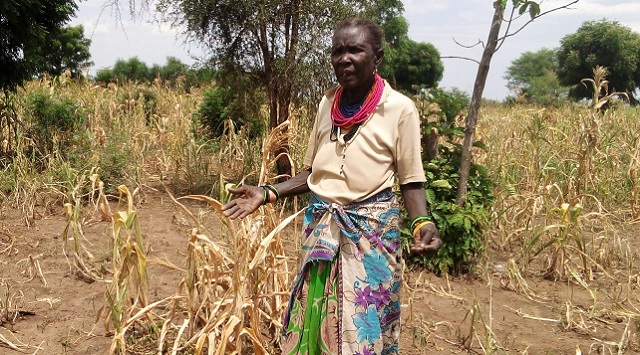
Moroto, Uganda | THE INDEPENDENT | Farmers in Moroto district counting losses following the prolonged dry spell that has destroyed crops in the gardens.
An estimated 10,000 acres of various crops such as maize, sorghum, bean, sunflower and groundnuts has been ruined by the drought that started in mid June and July.
Even sub counties like Katikekile and Tapac used to be most productive in maize and beans because of the fertile soil and reliable rainfall received at the foot of Mt Moroto have not been spared in the era of climate change.
Sarah Akello, a farmer in Tapac Sub County told URN that they cultivated very many acres of maize hoping to get high harvest, unfortunately their dreams have been shattered by the drought that has destroyed the crops.
Akello noted that the maize plantation was hit at a flowering stage and their only hopes are for the few crops which were planted in the mid April to May.
She observed that the change in the rain pattern has affected them because the resources were injected into the first season of cultivation with high expectations all in vain.
Akello said that as a result of crop failure, the families are already hit by hunger and the majority are now resorting to charcoal burning which has not a case been before.
She appealed to the government to consider supporting them with food relief because life is not going to be easy for them in the next coming month.
Regina Nachuge, another farmer in Naitakwae village in Nadunget Sub County said that she has lost all the five acres of maize and sorghum that she had planted in this season.
Nachuge said all the seeds were planted and they do not have any more incase rains come in the next season since the climate is no longer predictable.
Nachuge said the hunger situation continues as it has been before since all the crops that would give them hope have dried up.
She noted that people have already started migrating to other neighboring districts in Teso to work in people’s gardens and be paid using food.
Nachuge also added that some people have resorted to selling charcoal and firewood in town for an exchange for local brew residues.
Dr Francis Inangolet, the Moroto district production officer confirmed the calamity saying that crops have been ruined by the prolonged dry spell.
According to Inangolet, they expected bumper harvest from farmers this year following the good rains that started mid February but disappeared soon after the planting.
Inangolet observed that there have been no rains in the district from the month of June and the heat reached its peak in July causing terrible destruction of crops.
He said the climate change is getting harsher and the only way farmers can grow food is through an irrigation system that the government should consider seriously.
Inangolet said his office has already done the assessment on crop failure and anticipated critical food shortage up to the month of February in 2024.
Meanwhile, Esther Anyakun, the State minister for Disaster Preparedness and Refugee said that her office is aware of the hunger threat and the government is doing everything possible to contain the situation.
Anyakun said that in the last financial year, the government released 40 billion shillings for relief food items and some food has already been given out to the most affected households.
She also revealed that President Yoweri Museveni had promised to deliver some food relief to the people of Karamoja which is yet to be fulfilled.
The latest Integrated Food Security Phase Classification report compiled by the Ministry of Agriculture, Animal Industry and Fisheries, Ministry of Health with the United Nations World Food Program and other partners indicates that all the nine districts of Karamoja are classified as being at crisis levels of food insecurity.
This distressing situation mirrors last year’s findings where every district in the region experienced high levels of food insecurity or worse for the first time, without intervention.
*****
URN
 The Independent Uganda: You get the Truth we Pay the Price
The Independent Uganda: You get the Truth we Pay the Price


